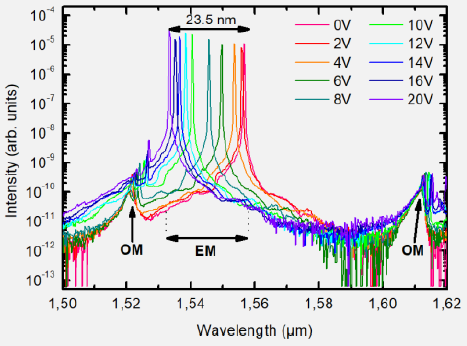Miniaturized tunable photonic devices can be of great interest for applications in wavelength division multiplexing systems or metrology applications. For a widespread deployment, such systems have to be compact, dynamically reconfigurable in wavelength, and with a low power consumption. To achieve such devices, many studies have been conducted in the past by using the MEMS technologies. However, MEMS solutions may have some drawbacks related to power consumption, high driving voltage or fragility of the MEMS structure. As an alternative to this MEMS approach, the use of the well-known and mature liquid crystals (LC) material within a monolithic microcavity structure has been proposed. After successful demonstration of a tunable photodiode in 2018 and 2019 which was used as a micro-spectrometer in the telecom Cband, we present here a tunable InP based Vertical Cavity Surface Emitting Laser integrating the same LC micro-cell technology than the one used for the photodiode. For such a device, laser emission in CW operation has been demonstrated for the first time with this LC based technology. This tunable VCSEL has been characterized under optical pumping with typical threshold of 6 mW, which is very similar to the one obtained with single frequency VCSELs realized without any LC micro-cells. This is an experimental evidence than optical losses introduced by the LC inserted in the VCSEL cavity are very low. Output power in the mW range is also demonstrated. As shown on the figure, without applying any voltage on the LC, VCSEL wavelength is centered at 1557 nm. The VCSEL output polarization state is almost fixed according to the LC alignment, corresponding to the extraordinary mode (EM) of the LC birefringent material. By increasing the applied voltage up to 20 V, this mode is bueshifted down to 1534 nm to achieve a wavelength tuning higher than 23 nm. On these lasing spectra, ordinary modes (OM) can be also seen. Expected to be unchanged with voltage, the OM are all slightly red-shifted. For a better understanding of this behavior, thermo-optical simulations have been conducted. By taking into account the heating properties of the LC and the reduction in its birefringence with temperature, all these wavelength shifts have been completely reproduced. Finally, by using LC with a better thermal tolerance larger tuning ranges are expected. Further works including investigation of the dynamical behavior of wavelength tuning are under investigation. Indeed, typical response time of such LC being in the millisecond range, a frequency chirp of 4 THz/ms could be also reached for coherent Lidar applications.

Article publié dans: IEEE PHOTONICS TECHNOLOGY LETTERS